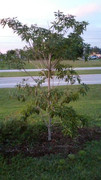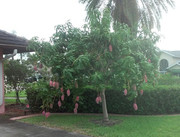I am still undecided about an early season "workhorse" mango. I have recently planted an Edward, 2 Pickerings, a Cogshall , a Mun Kun Si, Fruit Punch, 2 Maha Chanoks , and have Peach Cobbler, Venus, Beverly, and Keitt as later season trees. I had a pot-bound Duncan that did not survive transplanting that needs to be replaced. I have a Lemon Meringue that has mostly just sat for 2 years in the ground that has one more year to at least flush some growth before I get rid of it. I will save a spot for Guava and one for Frances Hargrave. I will probably plant a Glenn as the early season workhorse unless Zill is a good alternative.If Glenn wasn't so washed out with all the rain last year, (Valencia Pride was a disappointment too last Summer) I would probably have planted one already.
I will probably get some fruit most years before June from my other trees, but I would like a tree that would flood me with mangos while the others are starting to trickle in.
From the descriptions, Zill seems to be a decent enough mango if it can be done by mid June when the better stuff ripens in quantity.
From scattered bits of information I gather that it produces well ,has a bit of pineapple flavor, and can ripen in May,June and possibly into July. Another source said it has a tendency to ripen all of its fruit within about a 3 week period.If it is freestone as one source says that would be a plus. It would be great if it could be all harvested by mid June.
By then, some of the others I know we like will be producing enough to keep my ravenous family happy.
Zill doesn't seem to be propagated much now with all the hype around the newer varieties but I found one tree available nearby. Some of the sweetest and best women aren't in the fanciest wrappers....Same with mangoes.Some of the best of both species don't get the love they deserve.. It is Valentine's day after all! Make your ladies happy today....

Should I get a Glenn or the Zill? Or Florigon? My first Florigon died but I will try again if advised to. It took 3 Keitt trees to get one well established... I am on the Western edge of Cape Coral on the water less than a mile as the crow flies from Matlacha.



